#the outer series excerpt
Explore tagged Tumblr posts
Text
“Do you carry any weapons?” Rat interjected.
“I have a stunner,” Neuron replied. He had already replaced the stunner on his belt, so it was no longer hidden in his boot. “It won’t kill someone, but it’ll knock almost anyone out. It has a setting for droids and drones too.”
“Drones?” RJ asked. “Like, robots?”
“Yeah,” Neuron said, “but less humanoid, more… bug-like.”
“And that’s something you have to worry about?” Ariel asked. “Robots?”
“Unfortunately.”
“Unfortunately?” RJ asked. “That’s so cool! Much cooler than anything we’ve fought.”
#the outer series excerpt#the outer series#the fall of shatterthought#character: neuron#character: rat#character: Ariel#character: rj
3 notes
·
View notes
Text
(This is unedited)
For a second, Neuron felt nothing. No sense of feeling, or touch, no sense of anyone around him, no sound or sight.
And then, suddenly, the presence of others - four strangers, each surprised and startled - followed by the smell of dust. His sense of touch returned next, and with it his sense of gravity and temperature: he was laying down on his back somewhere with rough ground and hot air. He could hear the high-pitched whine of old electronics, and the lingering taste of smoke in his mouth, and then - finally - his sight came back.
The four strangers were staring at him with wide eyes. None of them were armed, nor were they ready to attack. Behind them, a cavernous empty room stretched. Bright fluorescent lights hung from the high ceiling, one of the lights flickering slightly and another shining only half as bright. There was a pile of supplies - backpacks, blankets, and something that might’ve been a bow - in one corner. No places to hide traps or weapons.
Neuron mentally checked himself over for injuries. He was starting to get a headache, but he felt no sharp pains or dull bruises. Whatever had transported him here hadn’t harmed him.
But where was he?
Neuron pushed himself onto his elbows to get a better look at the strangers. They all tensed at the movement - not hostile, but nervous.
Only one was in arm’s reach - someone who looked a few years younger than Neuron, with short blonde hair, pale skin, and bright blue eyes. The person was unscratched, despite torn-up clothes - likely invincible - and was crouched down, one hand out as if to protect the others.
The person in front said something, and it took a second for Neuron’s brain to catch up. It was in English - with some type of a North American accent.
“Please don’t be mad at us?” Another person said - the one farthest to Neuron’s left. They looked eighteen, at most, standing off to the side with hands shoved in pockets. The person had light brown skin and dark brown eyes, messy chin-length hair, and a large sweatshirt and baggy sweatpants.
“He doesn’t even know what’s going on yet,” the person in front said.
“What is going on?” Neuron asked.
“You got kidnapped,” the person in front stated.
“But not by us!” The second person said. “We are very anti kidnapping.”
“We can explain,” another person said - the one nearest to the person in front. “My name’s Rat. I’m the oldest, so I guess that means I’m in charge.”
Rat had a scar over one eye that gave him an experienced look, but even then he didn’t look much older than the others. He had blue eyes, suntanned skin, and blonde hair, and worn-out clothes covered in dust and patches.
“He’s not the oldest by much,” the person in front said.
“That’s Ariel,” Rat said. “She’s friendlier than she looks.”
Ariel scowled.
“I’m RJ,” the fourth person added. “And the bundle of nerves next to me is Monsoon.”
RJ also had patches on her clothes - mostly on her shoulders and knees. Her black hair was pulled back out of her face, showing off a bruise on one cheek - with her pale skin, the bruise really stood out.
“Hi,” Monsoon said.
“Like Ariel said,” Rat continued. “You were kidnapped, and now you’re here-”
“- and it isn’t our fault,” Monsoon added.
“And you’re with us,” Rat said.
“And we’re on the run,” Ariel added.
“And we’re on the run,” Rat agreed. “Which sucks.”
“The government here sucks,” RJ added.
“Everything here sucks,” Ariel muttered.
“And where is here?” Neuron asked.
The four of them exchanged glances, a worried energy forming. It was almost familiar - it reminded Neuron of debriefs where a scientist or expert had to deliver really weird news. We looked into what caused the explosions, and we think that someone engineered exploding ants. Or the perpetrators belong to a group who is trying to make fruit flies extinct.
“So, um,” Rat started, “well…”
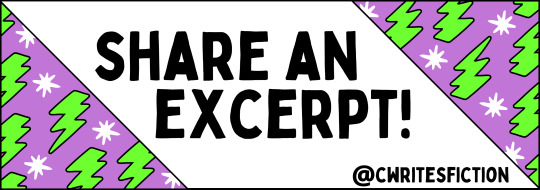
Share an excerpt that includes an exclamation point!
Check the reblogs to read others’ responses!
If you’d rather make your own post, no problem!
Click here for more “share an excerpt” tips.
#the fall of Shatterthought#the outer series#the outer series excerpt#character: neuron#character: ariel#character: rat#character: rj#character: monsoon
73 notes
·
View notes
Text
Roots - Chapter 20
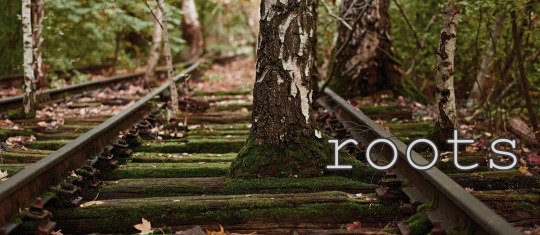
With the identity of the Final Inquisitor now revealed to the world, Ellana Lavellan (an investigative journalist) and Solas (a history professor) team up again to dive deeper into the mysteries of the Dragon Age as well as a series of strange phenomena that have been reported across Thedas. (Sequel to Overgrown)
Solas x Lavellan || Modern AU || Read on AO3 || Read from the beginning
Excerpt:
As quiet as Hunter Fell had been a few hours before, the town was now bustling with activity. The entire outer edge of the chantry plaza was filled with tables and stalls, and the crowd of browsers was large enough that Solas wondered just how much of the town's population had come out for the market. The wares were an eclectic mix - a wide variety of of crafts and artwork, but also tables piled high with both prepared food and raw ingredients. Ellana made a slow, deliberate circuit, her eyes sweeping curiously over each table as she offered their owners her generous smile. At first, Solas followed her closely, interested to hear the questions she asked while she browsed. But after a few minutes he fell back, watching her from a short distance away. He had missed an entire night's worth of photos thanks to his nerves at dinner, and he would not make the same mistake again.
#solas#lavellan#solavellan#solas x lavellan#dragon age#dragon age inquisition#solavellan fanfic#dragon age fanfic#modern au#roots#my writing
14 notes
·
View notes
Text
tuesday again 2/11/2025
the bon mot slot goes to the Witcher comics, bc after i inhaled all of the 2014-present series i realized they scratch the same sad goth detective itch batman does
oops! all books!
adding another axis to the "depressive cycles" graph, where x is "how many minutes of mother mother have i listened to in the past two weeks" and y is "how many books have i read and bounced off in the past two weeks" and brother we're at the extreme upper right hand corner
what was supposed to be last week's gay and/or lesbian romance and/or erotica

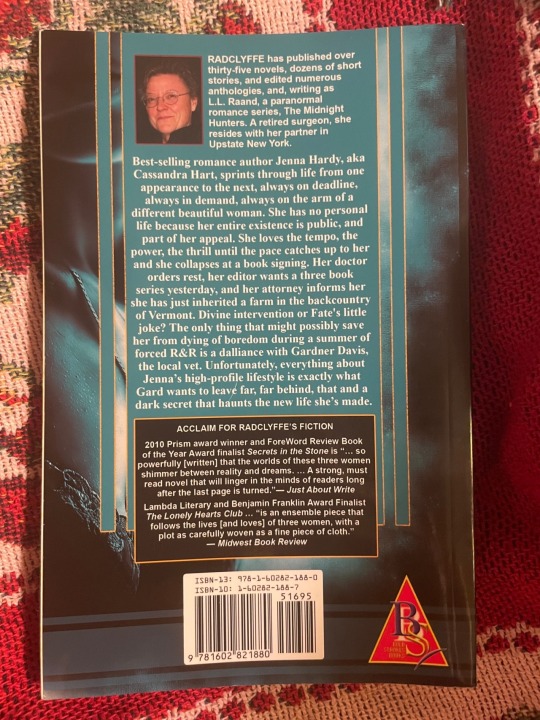
Desire by Starlight, by Radclyffe, is a 261p softcover published in 2010 by Bold Strokes Books. two unrelated facts about this physical object: VERY glossy cover, and smells faintly of mildew despite having a perfect text block with no water damage. radclyffe has written over a hundred books and this is somewhere in the middle. this is sitting at a solid 4 on goodreads with some complaints that she tends to be a little formulaic. i am going to be very honest and say that when i read this two weeks ago, i did not take very good notes bc i didn't love this one. the structure and pacing were mostly fine and there were only a few strange phrases in the sex scenes, i simply did not find it particularly memorable. we have for sure read worse during this project.
i wish the local love interest did not go by Gard, short for Gardner. is it a stupid old money new york name? sure. is it hard to take the book seriously? yes.
i also found it amusing that radclyffe does not follow her own novel-writing rule outlined in this very meta novel: rarely if ever does a scene open close to the heart of a chapter.

the secret our dear gard is hiding kind of fizzles out in the literal last ten pages. i think she should have had a better or more interesting secret instead of one that could be comfortably resolved through a singular therapy session. i also feel that this teetered on will-they-won't-they-let-each-other-through-a-hardened-outer-shell a little bit too long, and the breakthrough was perhaps not as cathartic as i would have liked. this excerpt, nearly halfway through the book, they are still not together. while it's very funny to watch them seethe in poorly concealed jealousy, i am tapping my watch. do something.


i cannot immediately find the weird wording that threw me a little during the sex scenes. the sex scenes are kind of widely scattered.
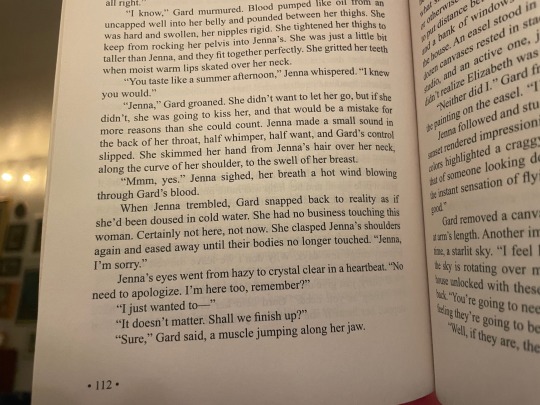
i think the thing that annoys me most about this book is that there's no real benefit for either of them in this relationship. jenna has broken down from not eating or sleeping well on a national book tour, not because she's psychically suffering from not letting see her feelings she keeps in a tightly locked box. there's no real benefit for gard either, who is lonely but not cripplingly so. it starts off as a casual-only thing and then both of them (and me) are startled they catch real feelings.
there are some gestures made toward It's Nice To Have Another Woman Around In Case of Physical Injuries Due To Mishap but i would have loved to see more of how gard was won over by being taken care of. gard princess carries jenna into her vet clinic bc of a fucked up ankle and jenna is annoyed, flustered, and doubly annoyed she's flustered.
i think this one was so forgettable bc i genuinely had trouble remembering what the conflict (if any) was. both of them are stable adults with real jobs and other friends. inheriting a farm in vermont doesn't really add any new or exciting problems for either of them. neither of them are very spontaneous and neither can manic pixie dream girl the other out of her shell, and when they finally do emotionally let their walls down it doesn't feel very organic.
the like technical putting words one after another is there, this is her zillionth book and everyone has dialogue that sounds like things real people would say out loud with their mouths and everyone's physical actions map onto my real-world understanding of how bodies in 3D space work. this one did not grab me.
-
this week's gay and/or lesbian romance and/or erotica
title drops in this book: 3.
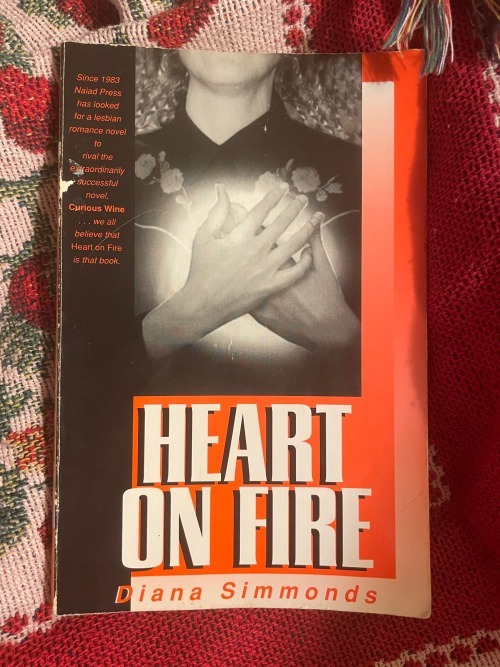
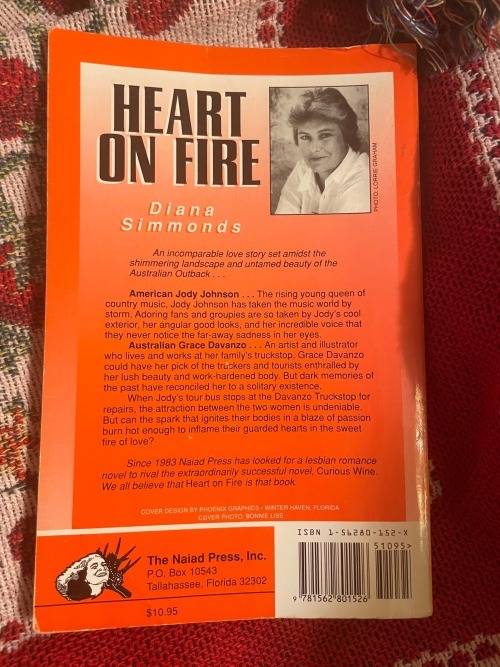
Heart on Fire is a 167p softcover published in 1996 by our old friend Naiad Press. a slightly water-damaged paperback i felt okay dragging down to the gulf when i was dragged down to the gulf last weekend for my health. this was Diana Simmonds' first solo book and first fiction book, and a lot of older lesbians seem to have a great deal of fondness for it. while i was trying to find any press or interviews, most of the hits were from other lesbian authors citing her as an inspiration. naiad really banked a lot on it being the hit novel of their publishing season and were sure it would eclipse their previous bestseller from nearly a decade ago, Katherine Forrest's Curious Wine. i don't own a paper copy but have placed a libby hold so we will make a detour from physical books in the near future.
overall, a rare book where the third act breakup does actually make a lot of sense: being the partner of a globetrotting traveling musician would put a strain on any relationship whether you choose to stay on the road or wait at home. however! it really did stick the landing! and for that i can forgive it a great deal! the sort of not quite reality of their respective third act depression sojourns and then the incredibly sensory descriptions of the finale concert…very good. very nineties movie about a musician ending if that makes any sense.
while i think the structure is fine, i think the actual craft of the narrative is more variable. we'll go into the style in the next paragraph, but part of the dedication goes "to CCC, without whom it would be full of people thinking to themselves." i wish CCC had dialed their feedback back a little bc i would have loved some more interiority, particularly from jody. i must commend our stuck-in-one-place half of the couple, grace, who makes SUCH fascinating decisions. the traveling musician jody looks like she could be the sister of her abusive ex-husband, grace's brief rebound from jody is her goddamn college advisor… bonkers. what ARE you doing???

stylistically, it feels like sitting on the patio of a lesbian bar for three hours and listening to a friend telling you a very long story about how two absent friends you don't know got together with a lot of elaborations and asides. i occasionally found this style tiresome. there are some charming turns of phrase, like "She wrote the address of the roadhouse on the package, sealed it with a kiss, said "What the hell," to neutralize the sentimental gesture, and dropped it into the mailbox." i also cackled out loud at "I don't know, I-- I really really want you, so much, and I am not very good at being cool about it." did nearly tear up at this paragraph:

some things have aged a little strangely since 1996. grace is briefly forcibly kissed by a very drunk bandmate before jody rescues her, but there are further instances of someone not immediately stopping a kiss or an embrace or what have you when someone else says no, that i think could not be written in a modern day romance novel. there are some very frank discussions of marital abuse right after a literally soul-healing sex scene.
this is a book that could never be rewritten as a straight romance with light serial numbers filed off. no one is in physical danger just because they're gay, but there's a lot of internal homophobia and readjustment on grace's part, and overall people are fairly accepting in theory but not always in practice. jody outs herself to the aussie press, and early on/right after her bus breaks down, grace and her mother discuss this news and her mother tells her off for being prejudiced, but connives to throw them together to distract grace from her recent divorce. her mother is then is very sad about the thought of her daughter who would have a very difficult life as a publicly out lesbian, and I can’t really blame her, but it’s such a switch from the vehement Fix Your Heart Or Die!!! discussion in the second chapter. there are some fraught familial reactions to grace's bisexuality-- her mom basically bullies her dad into remembering he loves his daughter-- but they all do come around.
this was fine and a good beach read, i'm not sure that i'll ever reread it. almost forgot about the sex. i think the current fashion for queer romance novels is not quite as purple, but the whole book is like this and i must respect an author's full commitment in this manner. here are some sex examples on non-consecutive pages.


-
did not finish, or finished with severe annoyance
i have become a libby power user in my old age bc texas is remarkably free with its library cards. i don't THINK i'm meant to have five of them but there seems to be no law against it and no one's told me to fuck off? this is good bc i have (at the moment) 44 holds and 56 "notify me if any of my libraries purchase this book" books tagged.
the flipside of being willing to give anything vaguely intriguing a try is that most books aren't very good or they aren't quite what i want. i will DNF anything, anytime, for no good reason. i know that statistically most novels are debut novels but i am so fucking tired of reading debut novels.

Hammajang Luck, by Makana Yamamoto, debut novel published last month. comps include ocean's 8, blade runner, and gideon the ninth. much as i love a heist novel, a heist is extremely ambitious for a debut and i didn't quite vibe with the style. i DNF'd at around the end of chapter seven, it has a very strange issue where we get from location to location pretty snappily but overexplain setting and clothing too much within individual scenes. i think it wants to be a screenplay a little too bad. a great deal of the dialogue is hawaiian pidgin (what the author grew up speaking). very much a me problem, i didn't have any experience with this language coming into this book and it was hard to turn off the kneejerk "this is racist and making fun of black people" response i had. again, very much a me problem.
Yamamoto uses Hawaiian pidgin—“an amalgamation of Hawaiian, English, Japanese, Chinese and Portuguese”—in much of the novel’s dialogue, particularly between Edie and their crew members. It is the “primary language” spoken on Kepler and speaks to the kinship between the characters. However, the decision to include pidgin occurred by happenstance. When writing the first line of dialogue between Edie and Cy, fellow crew member and friend, “it just came out in pidgin spontaneously”. Yamamoto “tried to rewrite it in standard English”, but it “sounded wrong”. Notably, the pidgin and Hawaiian words in the novel are not italicised or translated, nor does the novel include a glossary of terms. Yamamoto felt that these practices were “othering” and so asks the reader to do the work.
i think this is a reasonable thing to ask a reader, and i think i might have to take a crack at it some other time.
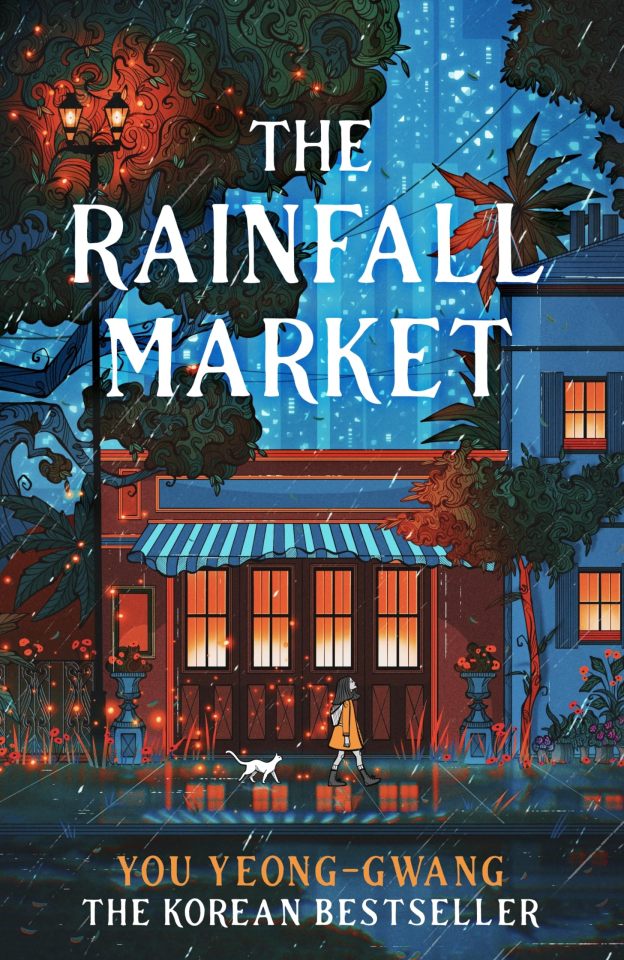
The Rainfall Market, by You Yeong-Gwang, a debut novel from last year freshly translated from Korean. a young woman wins a lottery ticket to enter the Rainfall Market on the first day of the rainy season, where she can completely change her life. DNF at two chapters. this seems to be generally marketed as general fiction (which is what my library had it under) but it feels very middle-grade, both as far as sentence structure and vocabulary and the general maturity-- the protagonist is about to graduate high school but her concerns and goals feel more like she's about twelve. not sure if it's an unfortunate series of translation and marketing decisions? rough!

Water Moon, by Samantha Sotto Yambao, the author's fifth book and published last month. the premise of this book is so charming: liminal-space pawnshop where you can exchange your regrets for tea, woman taking this family business over from her father, physicist who stumbles in, oh no! the physicist is playing the scully to her mulder but does not have a physicist Vibe. i think he’s too personable and not tiresome and mansplainy enough to be a particle physicist. he's too nice. she falls in love with him near-instantly. DNF partly because i have never met a particle physicist i could stand to be around for more than fifteen minutes, mostly a DNF bc at about a quarter of the way through this very slow to start book, when the girl turned to the boy after they fell through a pond into a perfect recreation of a edo-era tokyo street and said "this is the other world, you can call it isekai" i did not throw my elderly ailing phone across the room and i did not get up and stomp around bc phil was on my lap but i did vehemently return the library ebook thirteen days early.

Lucky Red, Claudia Cravens, a debut novel published summer 2023. this thoroughly fucking annoyed me. published by the literary group that also ran...basically a budget MFA? they called it a "novel generator in 12 months", they have since closed, and i cannot find how much AI was involved. i do not think this book was marketed well:
A thrilling, raucous, and gloriously queer debut about a scrappy orphan bent on making her own luck in the American West—and finding friendship, romance, and her true calling along the way, now in paperback.
this book is about an older teen in 1877 dodge city who turns to survival sex work. terrible thing after terrible thing happens to this girl whenever she makes a connection outside living just in her own head and for what? it felt like the author was setting up to deliver some moral lesson or theme other than "never question your boss" but never quite followed through. it felt like the author was punishing the protagonist for being a whore even though that’s the book the author chose to write and the author can't quite decide if it's empowering or not. again, it's very strange to read a book where the protagonist is punished for almost every decision she makes and very few parts of sex work are idealized, but then she turns to the camera and reassures the reader with a chipper "but it wasn't all bad!". i wish the protagonist got to mature or grow as a character a little more. i think this could have used more time in the oven and an ending that doesn't feel like a very ill-earned end of every american western ever. thank fucking god this is a real ensemble cast and not found family or i would be much more impatient with this book than i already am.
good at getting me to finish a book bc it's very effective at hustling you from chapter to chapter. great technical skill on that front. bad at any sort of emotional throughline.
things i DNF'd after less than two chapters

Thornfruit by Felicia Davin, published in 2018 and her seventh or eighth book. i am a little annoyed bc this was on hold for over two months but i really do appreciate the AO3-style list of tags and warnings in the front bc now i know there is stuff in this book that is not for me!
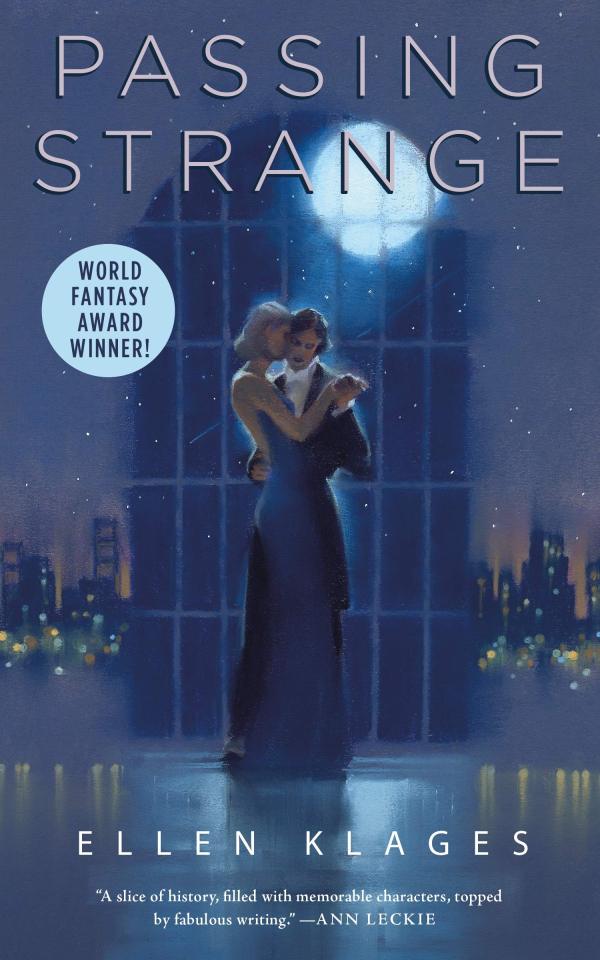
Passing Strange, by Ellen Klages, a 2017 novella and her...twentieth? work. a prolific woman. urban fantasy gay historical fiction of 1940s magical san francisco. while i do love a magical painting, i did not have it in me this week to read about a woman struggling with her legacy in the face of a terminal diagnosis.

Nevernight, Jay Kristoff, 2016 first book of a trilogy and his third trilogy overall. he keeps fucking getting me with fun vampire premises but he's very much in the same bucket as paolo bacigalupi in my brain. far more brutal and visceral things happen than you really are prepared for. do not love an opening chapter with disassociation to a past sexual assault in the middle of an assassination, as movie-crisp as the match shot transitions from present day to disassociation were.
plus a nice half dozen varied romances im not going to individually name, bc the last time i seriously used the "tag for later" feature in libby was the summer of 2019 and my tastes have changed. for example i rarely put myself through heterosexual vampire romance books these days.
-
yeah these were all right

Red Harvest, by Dashiell Hammett, his first full novel in 1929 after literally dozens of shorts and novellas. this detective noir was like watching a car crash. brutal little book. im positive this is not the earliest example of turning both ends of a town against the middle for your own profit, but it was the one cited for yojimbo so its the one that gets brought up a lot. i think the cast is slightly too large for what hammett is trying to do. sometimes reading noir as something woman-shaped feels like an elaborate act of self-harm.
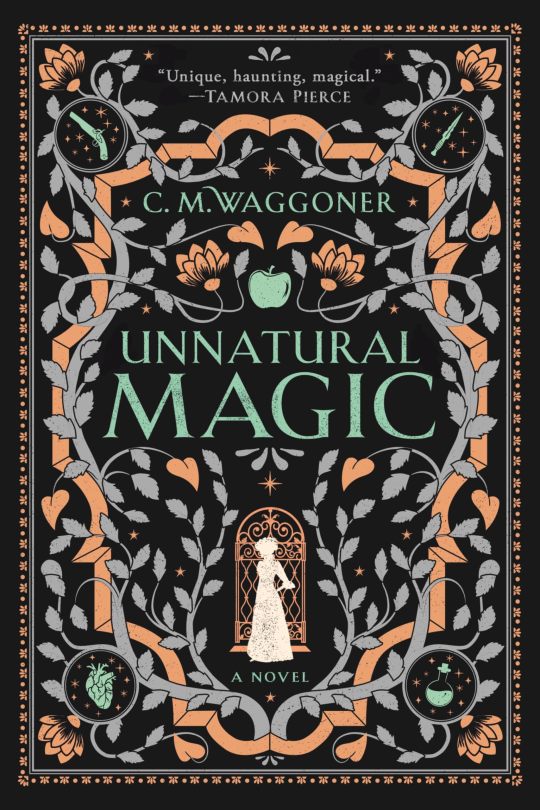
Unnatural Magic, by CM Waggoner, a debut novel from late 2019. thoroughly charmed by this one! one of the most well thought out country/species/religion/immigration systems and how any and all of those can impact any one specific wizard’s magic. it's like a beautiful clockwork orrery ticking along in the background. very prachett-esque approach to troll gender. the baddie is Not doing good things but the ultimate motivations are really understandable! I get why that happened even if it was a really bad reaction! a line i keep turning over in my head is "worry like a third person in the room." i have put their second book on hold on the strength of this one.
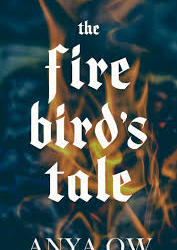
The Firebird’s Tale, Anya Ow, a debut novel from 2016. charming retelling of the fairytale element of a royal having to marry the one who makes him smile. the lead up to and the third act separation itself were kind of stupid, and felt like it wanted to be a duology but wrapped up very fast. has a lot of thoughts about choice and putting the end of things to bed quietly and with dignity on your own terms. also has a lot of thoughts about meanings of stories. the non-magical and non-immortal half of the couple is a possessive prince who falls so hard so fast and is mad about it. they fuck so many times while thinking "well surely this doesn’t mean anything, we're just married for the convenience". they're both so dryly exasperated.
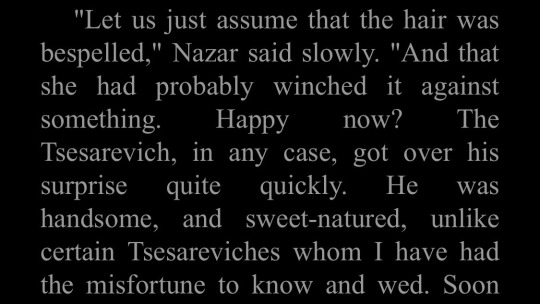
-
there's an additional hardboiled noir that was fun but i have nothing particular to say about, and a stack of physical comics from a new library that i mostly hated, but we are almost at the image limit and it is 1030 PM. i can't see why we wouldn't be back to the usual format next week but no promises bc there are no rules
27 notes
·
View notes
Text
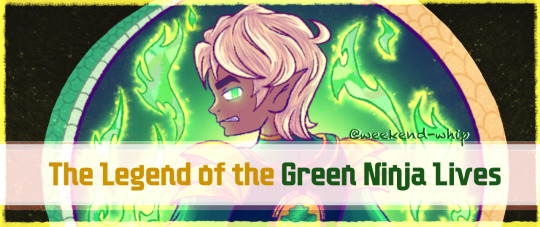
~Chapter 15: The Law of Conservation of Energy~
Summary: A 'good' school gets infiltrated by 'bad' people, a 'bad' school welcomes 'good' people with suspiciously open arms…and then there's Jesse, accidentally caught in the middle of it all as usual.
chapter link | story start | entire series
excerpt:
Lloyd knows better than to even consider complaining about their lack of mechs…but he’d forgotten how long trekking to Darkley’s on foot alone takes. He still remembers the days of aches his feet suffered after his very first arrival here— and when he was forced to leave.
"If only we didn't have to walk," Jay whines as he hovers two inches above the ground, lacking Lloyd’s reservations on complaining. Kai elbows him out of the air. “Hey hey hey ; still nursing a knee injury here…!”
“Well good thing I didn’t aim for the leg, then,” Kai grumbles, clutching at his sides.
“I for one have been enjoying the walk,” Zane hums, happily bird watching as they go along. “Though I do agree, the lack of efficiency is…regrettable.”
Therefore, it’s a relief when they get close enough to be able to read the school’s sign—‘Darkley’s School for Great Children’ emblazoned in gold letters and pressed into chestnut wood, and decorated with red lanterns to guide the way in dark times. A fresh, floral scent permeates the air, originating from the groupings of lilies and out-of-season blooming cherry blossom trees all over the lawn of the school.
…So, it’s an entire 180 on the vibes from the last time Lloyd walked this path.
“Was there… this many flower bushes last time we were here?" Cole asks, admiring the sheer amount of vegetation alongside the outer walls and the entrance path.
"Hard to remember," Kai coughs with a barely concealed smirk. "...Considering we were too busy crashing the Bounty's anchor through the roof."
Jay nudges Kai in the shoulder. “Shut up."
#ninjago#ninjago fanfiction#legacyverse#chapters#book 3#the legend of the green ninja lives#fic tag#fics of mine#works of mine#YEARS in the making here#and yet ch16 is the one i've actually been waiting for augh#already 6k deep into that one so#we'll see if i wind up posting on the last sunday of the month again :V#grab a drink and a comfort blanket friends
17 notes
·
View notes
Text
Cienie's take on Mandalorian Culture: Arasuum, the God of Death, not Sloth #3
The Funeral Rites of Taungs and later Mandalorian Warriors. <> Kad Ha’rangir and Mandalorian traditional weapons (part 1 — part 2 — part 3 – part 4 – part 5) <> Arasuum, the God of Death, not Sloth (part 1 — part 2 — part 3 — part 4)
Mandalorians: People and Culture was written as a handy guide - as I was proving in the previous part, some elements of the mentioned article do not fit well with widely understood Legends lore. I dare to say, it was never perfect source material even back in 2006, but it is still an important piece overall and the origin of Arasuum presented as a sloth god, albeit with no further details about the Mandalorian creation tale.
Chronologically wise, the next source material expanding our knowledge about Mandalorian mythology and religion comes from The Essential Guide to Warfare, written by Jason Fry and Paul R. Urquhart and published in 2012. In contrast to Mandalorians: People and Culture, this source book presented vital information about Mandalorian history in the form of in-universe academic text: Excerpted from “Industry. Honor. Savagery: Shaping the Mandalorian Soul” keynote address by Vilnau Teupt, 412th Proceedings of Galactic Anthropology and History, Brentaat Academy, 24 ABY
From the formal description alone we can establish some potentially additional context. Like:
⤿Brentaat is one of Core Worlds and as such was part of the Empire. This is an important detail as we need to remember that the imperial education system was pro-human and thus incredibly biased against alien cultures. As the Empire lasted more than 20 years (19BBY - 4ABY), we can’t cross out the possibility that some falsified history or, alternatively, deliberately concealed data influenced the current state of academic knowledge as at least one or two generations of human and similarly long living humanoid researchers earned their grades and academic titles under the Galactic Empire’s regime - a regime that was responsible for vast numbers of genocides and intentional destruction of non-human cultures but also everyone opposing Palpatine’s rule. Because of that, there is a great chance that modern scholars:
unconsciously based their academic research on incorrect data or
had no chance to examine the original written sources and archaeological finds because those were irretrievably destroyed or suitably hidden during the Empire era. Like what happened with Jedi Archives (available to scientists from various fields during the Republic era, confiscated by Emperor Palpatine) or Aldeeraan and Mandalore (intentional destruction of the planets).
⤿the “412th Proceedings of Galactic Anthropology and History, Brentaat Academy, 24 ABY” suggests a long academic tradition. Even if the recurring event continued through the Empire era, its roots date back to the times of the Old Republic. However, as mentioned above, two decades is enough time to influence academic environment.
⤿ the academic text was presented after Empire Fall. If we look at timeline from the perspective of Legends, the proceeding happened about a year before Yuzhaan Vong Invasion and after many political conflict between New Republic and Imperial Remnants. If we go with Disney New Canon, then Mandalore should be already rediscovered and recolonised after imperial genocide of the Mandalorian people (as seen in The Mandalorian TV series). In the case of the latter, it would make sense for the author to “celebrate” renewal of almost destroyed culture especially as a keynote address during an academic event dedicated to anthropology.
“Industry. Honor. Savagery: Shaping the Mandalorian Soul” discusses the period of time from Taungs leaving ancient Coruscant to the Clone Wars era (understandably not addressing the events from the final The Clone Wars season which aired in 2020). And so we have:
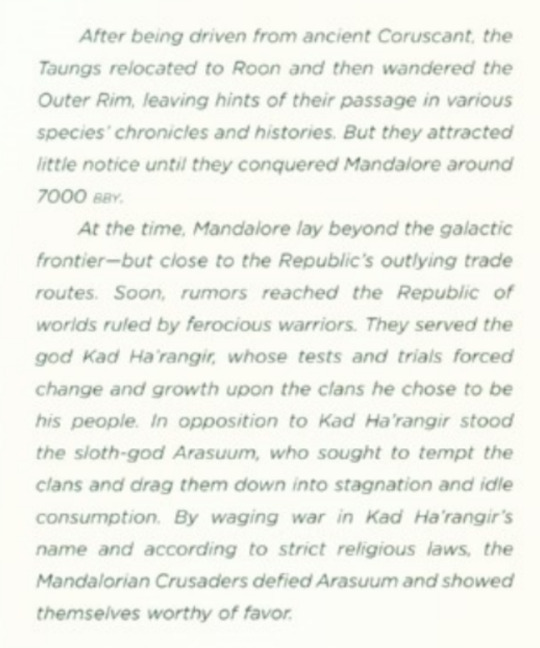
“After being driven from ancient Coruscant, the Taungs relocated to Roon and then wandered the Outer Rim, leaving hints of their passage in various species’ chronicles and histories. But they attracted little notice until they conquered Mandalore around 7000 BBY. At that time Mandalore lay beyond the galactic frontier - but close to the Republic’s outlying trade routes. Soon, rumors reached the Republic of worlds ruled by ferocious warriors. They served the god Kad Ha’rangir, whose tests and trials forced change and growth upon clans he chose to be his people. In opposition to Kad Ha’rangir stood the sloth-god Arasuum, who sought to tempt the clans and drag them down into stagnation and idle consumption. By waging war in Kad Ha’rangir’s name and according to strict religious laws, the Mandalorian Crusaders defied Arasuum and showed themselves worthy of favor.”
As Vilnau Teupt pointed out, the first information about Mandalorians and their religion reached the Republic in the form of rumors. Author does not specifically point out who brought such information, but we can assume the news travelled with the traders, smugglers or brave adventurers who for some reason wandered beyond Republic’s outlying trade routes. We have no idea if those people met in person with Mandalorian warriors (thus retelling their personal experience) or did pass second-handed information coming from the mentioned conquered worlds. This is especially interesting, as previously established lore suggested that Taungs (early Mandalorians) were rather set on whole destruction of those who weren’t able defeat them in the battle:
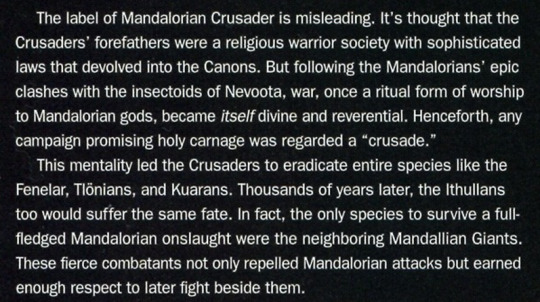
“The label of Mandalorian Crusader is misleading. It’s thought that the Crusaders’ forefathers were a religious warrior society with sophisticated laws that devolved into the Canons. But following the Mandalorians’ epic clashes with insectoids of Nevoota, war, once a ritual form of worship to Mandalorian gods, became itself divine and reverential. Henceforth, any campaign promising a holy carnage was regarded a “crusade”. This mentality led the Crusaders to eradicate entire species like the Fenelar, Tlӧnians, and Kuarans. Thousands of years later, the Ithullans too would suffer the same fate. In fact, the only species to survive a full-fledged Mandalorian onslaught were the neighboring Mandallian Giants. These fierce combatants not only repelled Mandalorian attacks but earned enough respect to later fight beside them. [The History of the Mandalorians, from Insider #80, 2005]
In the next paragraph, Vilnau Teupt himself mentions the destruction of Fenelars and Tlӧnians
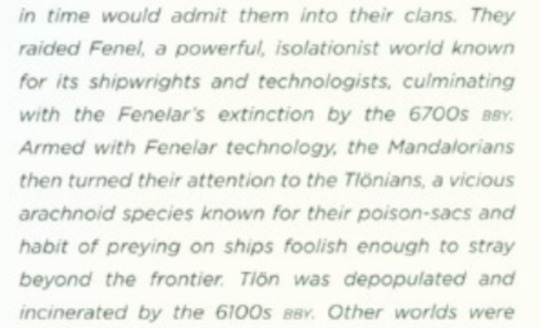
[Mandalorians] raided Fenel, a powerful, isolationist world known for its shipwrights and technologists, culminating with the Fenelar’s extinction by the 6700s BBY. Armed with Fenelar technology, the Mandalorians then turned their attention to the Tlӧnians, a vicious arachnoid species known for their poison-sacs na habit of preying on ships foolish enough to stray beyond the frontier. Tlӧn was depopulated and incinerated by the 6100’s BBY.
but also adds:
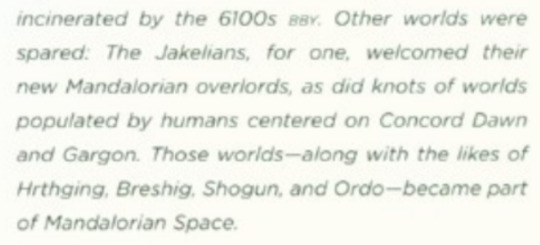
Other words were spared: The Jakelians, for one, welcomed their new Mandalorian overlords, as did knots of worlds populated by humans centered on Concord Dawn and Gargon. Those worlds - along with the likes of Hrthging, Breshig, Shogun, and Ordo - became part of Mandalorian Space.
While again, claiming that during Mandalore the Ultimate’s rule:
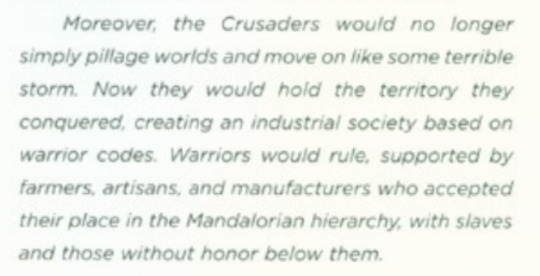
[...] the Crusaders would no longer simply pillage worlds and move on like some terrible storm. Now they would hold territory they conquered, creating an industrial society based on warrior codes. Warriors would rule, supported by farmers, artisans, and manufacturers who accepted their place in the Mandalorian hierarchy, with slaves and those without the honor below them.
This creates a potential conflict with the older lore, as Mandalorian warriors (Taungs) were prone to destroying encountered species, holding in respect only those as brave and mighty as themselves. Why in times before Mandalore the Ultimate, would they spare those who willingly give up on their independence? Why would they even bother to be overlords, when ancient Mandalorians were nomads, travelling from one world to another? Cassus Fett, a right-hand of Mandalore the Ultimate even called this the “nomad’s curse” [Knights of the Old Republic comics series, issue #23, 2007]:
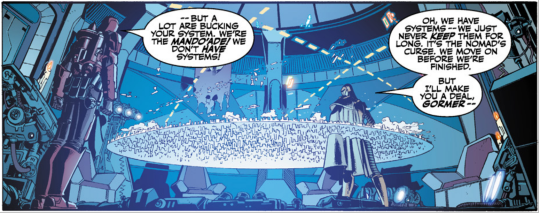
Gormer: [...] We’re the Mando’ade! We don’t have systems? Cassus Fett: Oh, we have systems -- we just never keep them for long. It’s the nomad’s curse. We move on before we’re finished.
Of course, agricultural planets like Concord Dawn could be useful for providing food and other needed goods or services to their overlords, as a sort of tribute which in return could allow warriors to focus on honing their battle skills without worry for mundane tasks. The problem again lies in the nomadic ways of ancient Mandalorians (Taungs), as we need to remember that A) space travelling was much more primitive and limited than in modern times and B) the crusades took the warriors into far corners of the galaxy for long periods of time, and they needed a secured access to provisions. Which raises a question about the logistic nature of transporting large food supplies far away beyond Mandalorian Space and if it would not be easier for Crusaders (Taungs) to simply take the needed goods from conquered worlds (as author himself noted!) than rely on their human subjects? If people of Concord Dawn or other conquered worlds travelled with their masters, some could adapt the warrior culture as their own though officially non-Taungs were allowed to join Mandalorian ranks as equals under Mandalore the Ultimate’s rule. If Crusaders did not stay too long on one planet, would people of conquered worlds have time to fully understand their religion, culture and custom to become a reliable source of knowledge for the Republic?
If indeed before Mandalorian Wars, Crusaders (Taungs) spared some planets from destruction and ruled over the human populace, we may assume their social structures were more complex than it is believed to be. The division between warriors - lords - and the subjected population could also influence Mandalorian religion. If Kad Ha’rangir was the main deity of Mandalorian Crusaders, then those who did not pursue warrior’s life and continued to be farmers, miners, blacksmiths or fulfill any other mundane occupation, the Arasuum’s “idle consumption” may be redirected on the lower part of society now. In that sense, a warrior successfully tempted by Arasuum would give up on fighting, settle down and become a farmer themselves, losing the high social position.
Another thing that differs from the mentioned History of the Mandalorians is the claim that Taungs-early Mandalorians served one god (Kad Ha’rangir)[1] and waging wars was a necessary act to defy Arasuum. Which suggests that Arasuum’s power over Mandalorians was believed to be a real danger, if warriors needed to prove their worth in Kad Ha’rangir’s eyes. Frankly, this religious division reminds me more of god vs satan-tempter dynamic than any ancient religion, albeit with an ironic twist, as the “good god” is called the Destructor while the “tempting to evil” deity is connected to peace and idle consumption. Looking at our real-life geopolitical situation, I imagine a great number of people would actually want to fall under Arasuum’s rule to finally have some sense of stability and prosperity. Which on one hand illustrates well how different the morality of Mandalorian Crusaders was from our real world and in-universe Republic. However this academic text demonizes Arasuum, in the sense, his status of god is not acknowledged as he plays more the role of “devil”. In contrast, the History of the Mandalorians paints a different picture, one in which early Mandalorians (Taungs) saw "war as a ritual form of worship to Mandalorian gods". Understandably, said gods were not named yet, but if we agree this statement now includes Kad Ha’rangir and Arasuum, we could assume that latter played a more vital role than just being the enemy - especially since he was part of Creation Tale known as Akaanati’kar’oya (The War of Life and Death), mentioned by Mandalorians: People and Culture. If a war was seen as a ritual form of worship and ancient Mandalorians interpreted the myths as literal supernaturalism (as stated by Mandalorians: People and Culture), then any battle could be seen by ancient Crusaders as symbolic reenactment of events from a well-known myth. Thus Arasuum would be an important figure no less than Destructor himself. Because if Kad Ha’rangir identifies life, then Arasuum logically should represent death. Which fits what Canderous Ordo said in Knights of the Old Republic game (2003) when prompted by the player:
Player: The Mandalorians destroy worlds for honor? Canderous: Win or lose, as long as the fight is worthy, then honor is gained. The glory at having triumphed over impossible odds is what drives us. If there's nothing at stake – your possessions, your life, your world – then the battle's meaningless. We Mandalore take everything we are and throw it into battle. It's the true test of yourself – the battle against death… against oblivion.
or
Player: You seek death? Canderous: All life dies eventually. A true warrior is one who can beat it down whenever it raises its head. But…
or
Player: Then what are you doing now? Canderous: The days of combat and glory and cheating death at every turn seem to be over now… I take what I can.
Again, the “stagnation and idle consumption” could be treated literally or could be a metaphor for unchanging death and the “peaceful homestead” offered in afterlife. Additionally, since “Industry. Honor. Savagery: Shaping the Mandalorian Soul” in-universe was presented in 24 ABY but Death Watch Manifesto (included in Boba Fett’s Files) fell officially into Rebels’ hand after bounty hunter ended in Sarlacc’s pit, as was seen in The Return of Jedi (4 ABY). An official rapport mention that Fett’s personal items found on Slave I were “examined prior to archiving"
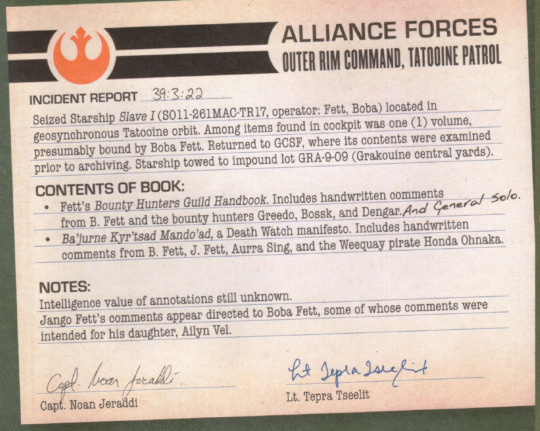
so we can’t cross out the possibility that once the Empire fell and the Rebellion transformed into the New Republic, historians and researchers got access to those files. Thus there is a chance the “Industry. Honor. Savagery: Shaping the Mandalorian Soul” represents a take on Arasuum influenced by Death Watch Manifesto - about which I will talk more soon.
Another paragraph important to our understanding of Mandalorian religion mentioned shift in perception of gods:
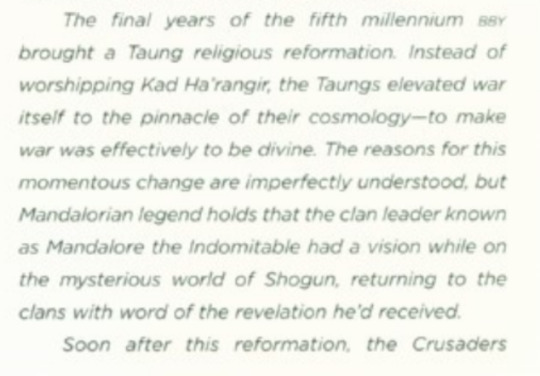

“The final years of the fifth millennium BBY brought a Taung religious reformation. Instead of worshipping Kad Ha’rangir, the Taungs elevated war itself as to the pinnacle of their cosmology - to make a war was effectively to be divine. The reasons for this momentous change are imperfectly understood, but Mandalorian legend holds that the clan leader known as Mandalore the Indomitable had a vision while on the mysterious world Shogun, returning to the clan with world of the revelation he’d received. Soon after this reformation, the Crusaders raided the galaxy’s central systems. In 4024 BBY they attacked the planet Nevoota in the Colonies, exterminating its species during a three-year campaign.”
One one hand, as a source author lists a Mandalorian legend - although that alone does not provide a historical context[2] of when said legend originated. Is this an ancient source preserved in written or electronic form? Or some folklore tale passed through generations and growing in additional details alongside? One way or another, we are provided an example that Mandalorian religion A) was not a stagnant matter and B) the important change influenced the warrior society and C) most of Republic knowledge about Mandalorian Crusaders comes from times after the reformation (The Sith War, Mandalorian Wars and forward) but as author pointed out, the “reasons for this momentous change are imperfectly understood”. Which suggests that the Republic academic environment has limited understanding of Taung mentality.
It would definitely help if the author provided more sources on which this academic lecture was based on. At the same time, all the deviations from widely understood lore can be easily explained as the author's limited knowledge due to factors beyond the control of scholars (destroyed or fragmentary sources, growth of legends around ancient events, impossibility of verifying data). The society of Taung (ancient Crusaders) is much more complex and if indeed they kept conquered worlds like Concord Dawn in which farmers were supporting the ruling caste of warriors, this experience may influence their religious understanding of Arasuum’s idle consumption and laziness.
Bounty Hunter Code: From The Files of Boba Fett was co-written by Daniel Wallace, Ryder Windham and Jason Fry. Similarly to The Jedi Path: A Manual for Students of the Force (2010), Book of Sith: Secrets from the Dark Side (2012) and Imperial Handbook: A Commander's Guide (2014) this is a reference book presenting events from the perspective of characters and not an all-knowing narrator. Each book also contains additional notes written by certain characters who at some point read it and for this or another reason were motivated to add their own commentary. What provided us both the in-universe knowledge and often a counterargument coming from a different “point of view”.
Death Watch Manifesto, in mandalorian language known as Ba'jurne Kyr'tsad, is supposedly written by Tor Vizsla. As author claimed, the content of the Manifesto was meant for Death Watch members chosen among other things to train and educate recruits:

You are reading this because you have been chosen as a Rally Master, charged with training recruits, preparing Watchers for operations and commanding them in battle. Like Cassus Fett's Rally Masters of ancient times, you must educate and inspire our warriors, so they understand their heritage and will sacrifice their lives for it."
The Ba'jurne Kyr'tsad at some unspecified point of time fell into Jango Fett’s hands and was passed down to his son, Boba (thus included into titular files of Boba Fett). Jango himself questioned the authenticity of the author:

I wonder if Vizsla really wrote this. He was a thug. Sounds more like Priest, or Reau. Maybe the younger Vizsla. That one likes speeches - JANGO
But as Fett noted down the Manifesto sounds as something certain Mandalorians could say. Going so far to name Pre Vizsla, Isabet Rau or Dread Priest as examples and two of those mentioned characters were working for him as Mandalorian Training Sergeants on Kamino. So whoever the author truly was, we have no reason to doubt the Death Watch Manifesto was written by Mandalorian for Mandalorians and the presented here political statement could be even shared beyond the Death Watch group. We also have a rough time frame for better analysing the source - it was written after the Battle of Galidraan (44 BBY) and if Tor Vizsla indeed was the author, before his death in 42 BBY.
As was already said in “Kad Ha’rangir and Mandalorian traditional weapons, part 2”, analysing Ba'jurne Kyr'tsad is not an easy task, as we need to tread between historical data and the author's subjective opinion. Among other things, author described repression that happened upon the traditionalists, such like exile to Concordia and intentional destruction of their culture:
“Seven centuries ago, their craven, hut’uune warships and Jedi bombarded our worlds. They incinerated Mandalore’s farmland and forests, leaving much of our homeworld a forsaken desert of fine white sand, and then occupied our worlds. They killed, exiled, or disarmed our warriors and suppressed our ancient codes.
or
“Our secret operations on Mandalore and Concordia are producing more and more beskar, but Mandalorian armor remains hard to find - and the New Mandalorians treacherously destroyed many heirloom suits of beskar’gam.”
and
“Some of our warriors were exiled to the moon Concordia. Others - myself included - slipped away to resume the ba’slan shev’la”.
If we agree it’s true that the warrior culture was systematically erased for centuries within Mandalorian society[3], then we must ask a question: how truthfully is the knowledge provided by the author? [4]
Our best chance to determine how well information is presented here, is to look at additional commentary provided by Jango Fett. Mentioned above Jango’s comment was written on the margin of the fifth page (sixth, if we count the author's introduction as starting point) and was his first note addressing the content of presented text. The manifesto was written with a certain political message - thus with no doubt is not an objective source material - yet a great chunk of the information up to this moment is about Mandalorian history and culture from ancient to modern times. Fett did not polemize with historical knowledge contained in the book while most of his comments are in fact about Jaster Mereel (modern times), weapons or remarks about Tor Vizsla and Death Watch. So either, Jango
had no sufficient knowledge about the ancient times to question author’s claims
did not notice anything suspicion in provided data
didn’t care about the history aspect thus did not bother to comment on it.
Although Jango was not a fan of reading, he was raised by Jaster Mereel, the leader of True Mandalorians whom Montross accused of forgetting Fett was not his son. As we know from various sources, both True Mandalorians and Death Watch were once part of the same Mandalorian Mercs group, so if historical knowledge was passed between warriors, then Jango had a great chance to learn it from Mandalorians (Jaster) who took him into their ranks when he lost his biological family. As Fett did not critique the historical data provided by author and even commented the arguments and/or rhetoric sounds more like something his own people may say than Tor Vizsla (whom he considered to be just a thug), I think it is safe to assume the historical knowledge of Death Watch is similar to those passed down within True Mandalorians.
Thus for the lack of proper counterarguments, I will assume the historical aspect of Ba'jurne Kyr'tsad reflects the knowledge of modern Mandalorian warriors. Establishing that, let’s take a closer look at the Arasuum and Mandalorian religion.
One of the most important things in which Ba'jurne Kyr'tsad differs from Mandalorians: People and Culture is the certainty about Mandalorians’ origins. Here, there is no doubt about the connection between modern culture and the now-extinct Taungs, whom the author calls his people’s ancestors even if they have never shared the same blood.
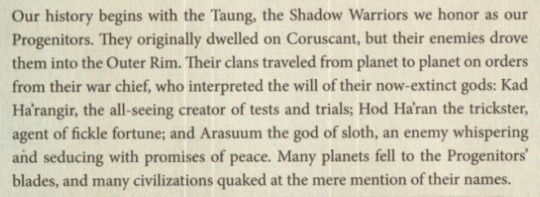
THE TRUE HISTORY OF THE MANDALORIANS Our history begins with the Taung, the Shadow Warriors we honor as our Progenitors. They originally dwelled on Coruscant, but their enemies drove them into the Outer Rim. Their clans traveled from planet to planet on orders from their war chief, who interpreted the will of their now-extinct gods: Kad Ha’rangir, the all-seeing creator of tests and trials; Hod Ha’ran the trickster, agent of fickle fortune, and Arasuum the god of sloth, an enemy whispering and seducing with promises of peace [...].
Author pointed out the religious nature of Taung and later, early Mandalorian culture (supported by various tie-in source material) in which the war chief interpreted the will of gods. Interestingly, all three main deities known to us - Kad Ha’rangir, Hod Ha’ran and Arasuum were included as those influencing the life of ancient Mandalorians.
The additional graphic presenting said gods adds that “ancient Mandalorian deities were led by the all-seeing Kad Ha’rangir”, so although there was hierarchy between gods, Arasuum is part of the pantheon and not a minor god himself [5].
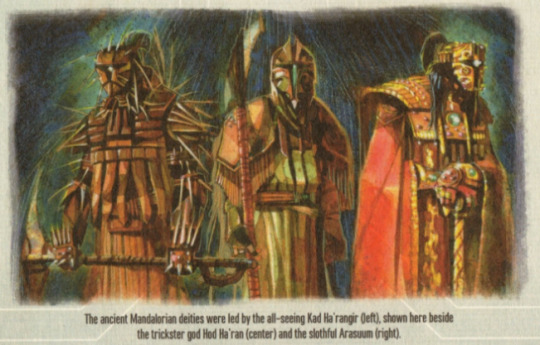
Arasuum is here called the “enemy whispering and seducing with promises of peace” but considering how the author segregates Mandalorians into two categories: the “faithful” followers of old (warrior) traditions and “faithless” who rejected it, we should ask: is this an accurate mythology role the god fulfilled in the ancient times, or is it solely the author's political allegory reflecting the conflict between Death Watch and New Mandalorians?
As was mentioned before, Death Watch Manifesto is as much about passing knowledge to their members as upholding a specific ideology. So on one hand, we have an old symbol of Crusaders that author described as:

The ancient symbol of the Mandalorian Crusaders is a ring adorned with shape points. The points represent the weapons of warriors, while the ring symbolizes the cycles that govern life - birth and death, conquest and defeat, and the promise that new warriors will arise to carry the traditions of the departed.
If the ancient Mandalorians (Taung) believed life is a cycle, in which birth and death, conquest and defeat follow each other, then logically war and peace were inextricably linked too - even if the time between “official” wars against Republic or Sith was used for preparation for another attack, as happened after The Sith War (rebuilding forces under Mandalore The Ultimate) and after Mandalorian Wars (Canderous Ordo’s Mandalorian Outpost on Dxun).
Looking at the mando’a language, the term of “peace” has connection to words like “healing” and “rest”,
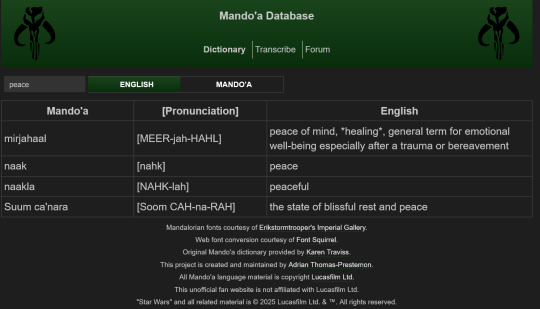
while the Mandalorians: People and Culture mentioned a “permanent, peaceful homestead” located in traditional afterlife, in which wives and children were living[6], defended by warriors who joined the army of the dead. So we could draw a connection between the ancient Mandalorian concept of peace, healing, and even “permanent” resting (death).
If Arasuum originally was the god of death, then “seducing with promises of peace” could as well be a metaphor for giving up on life. In that sense the epithet of “god of sloth” makes sense, as being Mandalorian meant constantly facing danger and hardship and overcoming the odds. Thus those who lost their will to fight (staying alive) could be considered by the community as “lazy”.
At the same time, the short description of Mandalorian gods mentioned Hod Ha’ran as the trickster, yet the author completely omits his role. All the “tricking” is moved on Arasuum alone. And so according to author, the deity seduces Mandalorians “with promises of peace” or in general the unfortunately for Mandalorians ages are assigned to happen under Arasuum’s rule:

After Ani’la Akaan, weak Mandalores led the clans, and our honor ebbed - these were the years of Arasuum, The Stagnation.
Unsurprisingly, author attributes Arasuum’s negative traits to Republic, Jedi and New Mandalorians:
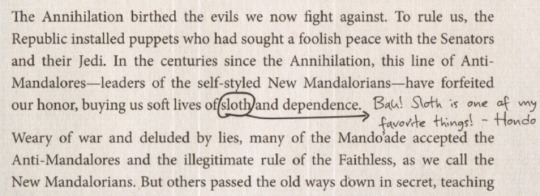
The Annihilation birthed the evils we now fight against. To rule us, the Republic installed puppets who had sought a foolish peace with the Senators and their Jedi. In the centuries since the Annihilation, this line of Anti-Mandalores - leaders of the self-styled New Mandalorians - have forfeited our honor, buying us soft lives of sloth and dependence. Weary of war and deluded by lies, many of the Mando’ade accepted the Anti-Mandalores and the illegitimate rule of the Faithless, as we call the New Mandalorians.
or

Meanwhile, centuries of New Mandalorian lies had left the Mando’ade weak and soft. One of my kinswomen, the Duchess Satine Kryze, had been sent offworld as a child by her father, a mighty clan warlord, and she fell prey to the lies of the Jedi. After her father perished in the Great Clan Wars, she betrayed his memory by becoming the leader of the New Mandalorians. Aided by Jedi tricks, she became the newest Anti-Mandalore, whereupon the exhausted Mando’ade flocked to her banner.
Adding to this all paragraphs mentioning how the Faithfull Mando’ade faced and overcame hardship (deliberate destruction of warrior culture) that made them stronger, there is no doubt that the author is using extinct gods as metaphor for political conflict: the Mandalorians keeping old faith are those tested by Kad Ha’rangir, those accepting pacifism are deluded by lies of Arasuum[7].
Thus Death Watch Manifesto can’t be treated as an objective source on which we could base the reconstruction of an extinct religion. On one hand, modern Mandalorians must be somehow aware of who Kad Ha’rangir and Arasuum were to read between the lines of what the author is trying to imply here. On another note, the short introduction at the beginning of Ba'jurne Kyr'tsad may be what the ancient gods were already reduced to - a symbol in the centuries old fight between two opposite ideologies. At the same time, it supports Mandalorians: People and Culture’s claim how modern Mandalorians treat old mythology “as parables to illustrate a deeper philosophical meaning rather than literal supernaturalism”.
As was mentioned before, there is a chance that Ba'jurne Kyr'tsad became available as a historical source for academic use. Thus could influence how modern (post-Empire) scholars interpret ancient culture of Mandalorian Crusaders.
After examining three different sources - Mandalorians: People and Culture (handy guide), Excerpted from “Industry. Honor. Savagery: Shaping the Mandalorian Soul” (in-universe academic text) and Ba'jurne Kyr'tsad (in-universe half guide, half political manifesto) our knowledge about religion of Taung-ancient Crusaders is still limited to the point, it is hard to tell for sure what is an accurate knowledge and what is modern reinterpretation of old myths.
Because of that, the next part will focus on widely understood Mandalorian culture and what the characters and narrative can tell us about the original warrior religious dogmas.
SIDENOTES
[1] Additionally, The Essential Guide to Warfare includes an in-universe translation of the best-known section of Dha Werda Verda that presents the ancient battle between the Zhell and the Taungs. Here it is revealed that pre-Mandalorian society of Taungs believed in supernatural being called Maker, which may be a totally different deity than Kad Ha’rangir. Or alternatively, the Maker has evolved into Kad Ha’rangir.
[2] Source material doesn’t agree when the religious reformation happened. The Essential Guide to Warfare attributes the change to Mandalore the Indomitable, while The Old Republic’s lore entry suggests it happened before said leader rose in power.
The Old Republic game’s Galactic History 42: The Nevoota Extinction codex Lore Entry: This datacron holds unheard of power and knowledge collected by an ancient race. You access its power and discover writings which are clearly only one small piece of a massive galactic history: Some years before the Old Sith Wars, the Nevoota–a species of insectoid aliens from the Balmorra system–found themselves facing an army of disciplined warriors in distinctive armor. The warriors were Mandalorian Crusaders, testing themselves against the galaxy’s deadliest species. However, the Nevoota were a challenge even for the Mandalorians. Possessing superior numbers and utterly disdainful of death, the Nevoota fought a four-year campaign under the cunning warlord Ithcharaka–but finally the Mandalorians hunted the Nevoota to extinction. This conflict had a profound effect on Mandalorian culture. The Mandalorians began to see war itself as an end, not just a means of conquest. Through war, Mandalorian society found its highest expression. When Mandalore the Indomitable eventually rose to power, he led a people who demanded nothing less than the greatest challenges the galaxy could offer.
[3] Repression aimed at warriors were implied by The Clone Wars: The Mandalore Plot episode, in which Prime Minister assured Obi-Wan Kenobi that their warriors were exiled and died out decades ago:
Almec: I welcome you as a servant of the people, but I am troubled by the false rumors that brought you here. Mandalore would never turn against the Republic. The Duchess Satine values peace more than her own life. Kenobi: I'm aware of the Duchess' views. Almec: Master Kenobi, Mandalore's violent past is behind us. All of our warriors were exiled to our moon, Concordia. They died out years ago.
[4] According to Ba'jurne Kyr'tsad, the ancient tradition was passed in secret for ~700 years to uphold customs that warriors should consider sacred. Logically then, after such a long time Tor Vizsla or whoever wrote the Manifesto under that name may simply repeat already whitewashed “history lessons” that for ages fitted “Faithfuls’” needs. In that case the author himself may not lie on purpose and simply presents the incomplete or twisted knowledge passed through generations between traditional Mandalorians.
At the same time there is the possibility that the author deliberately presents information in a way that fits the Death Watch’s rhetoric to manipulate/encourage readers to his case. This doesn’t automatically mean the author is lying about events per se, as the Sith War, Mandalorian Wars and Republic attack on Mandalore did happen and have confirmation in different sources, however the manner of presenting is clearly non-objective.
Of course, those two options don’t exclude each other and may easily co-exist, as the author operates on knowledge passed down to him while presenting it in a favorable way to supporters of Death Watch.
[5] The importance of Arasuum is supported by the Creation Tale known as Akaanati’kar’oya (The War of Life and Death), mentioned by Mandalorians: People and Culture.
Additionally, Arasuum was presented on the picture in the outfit looking the richest of all Mandalorian deities; the red cloak, golden-like plates with some gems brings to mind luxury that ancient Taung and Mandalorians didn’t seek or hold in great regard. But if this deity represents “idle consumption” and sloth, we should ask, how did he become so rich in the first place? This reminds me how some real-life chthonic deities connected to death and underground like Greek Hades or Slavic Veles had also strong ties to prosperity and wealth. As beskar is the most important Mandalorian wealth, I wonder if there could be a link between beskar and the potential deity of death, if Death Watch Manifesto mentioned the concept of non-Taung vassals who were serving Mandalorian clans as metalsmiths. The blacksmith knowledge was held in high regard and was one of the most well guarded secrets, so one’s skills could be respected (and well-paid?) while the person in question didn’t need to be warrior.
[6] As I mentioned in previous part, the traditional afterlife’s gender division doesn’t fit what we know about Taungs and early Mandalorians, however author of Ba'jurne Kyr'tsad provided insight into old social structures, in which Mandalorian warriors were supported by vassals responsible for various tasks, like blacksmithing:
The Progenitors saw hand-to-hand combat as the warrior’s highest calling. Their helmets resembled their own faces, and each suit was custom-made for its wearer, with the armor of venerated ancestors melted down and reforged to equip a particularly valorous war chief or clan leader. Some forged their own armor, while others left that task to metalsmiths serving their clans as vassals.
or
Under the Uniter and strong Mandalores who followed him, our homeworld became the protector of many star systems and the center of an honorable civilization. Warriors ruled, protecting the artisans, manufacturers, and laborers who supported them and who were supported in turn by vassals and servants.
So maybe the traditional afterlife was not divided by gender and age in which women and children were delegated to peaceful homestead but into souls representing warriors and non-warriors? The first continued their fight as part of the army of dead. The letter, like ancient vassals, supported said army by providing food (farmers), armors (blacksmiths) among other things?
[7] This way the author can critique the “faithless” Mandalorians without actually demonizing them - they aren’t bad Mandalorians, but ones “seduced” by the Arasuum’s promises of peace and sloth. Which makes sense, as the author himself noted how divided is the modern mandalorian society.
This division between the Faithful and the Faithless split every clan: members of the Ordos, Fetts, Kryzes, Awauds, Priests, Gedycs, and yes, Vizslas belonged to both sides in our long struggle.
#star wars#arasuum#kad ha'rangir#cienie's take on mandalorian culture#mandalorians#mandalorian culture#mandalorian religion#taung#ancient mandalorians#cienie's meta
16 notes
·
View notes
Note
Armament for the wip game 👀
Armament is a Zosan whump series that I chip away at when I'm feeling savory. My hope is that maybe each will bloom into it's own standalone story but for now they live in that doc as a possible like 5+1 type of thing.
Here's an excerpt from one of them:
Three doors down on the left is the ornate mansion door the guards had been posted at. It’s also the only one in the hallway with two sets of steel bars fastened to keep it shut.
No… that wasn’t right.
They were braced to keep someone in.
The outer edges of the wood door were charred, the paint cracked and peeling from heat.
“Can you get this or do I need to find a way to unfasten it?” Usopp asks, gesturing to the steel beams.
“I’ll handle it,” Zoro replies, bringing Kitetsu down in a tense downward strike.
The metal bars bracing the door fall away and Zoro’s forcing his way through scorched wood before the metallic clanging stops.
The parlor is a large, opulent room. There are various pieces of smoking, crisp furniture shoved against the walls. A rug in the middle of the room trails smoke from its tassels.
And there, in the middle of the parlor, is a man chained to a metal chair. His still body is hunched forward and there’s a brown sack fixed over his head. Tendrils of blond hair drape below the edge of the sack, the locks curled against a blue dress shirt.
Zoro freezes. The body is so- so still and it strikes him with terror.
He holds his breath and wills himself to move but feels as if he’s made of lead.
Then.
“Chou?”
The word is quiet. It’s a hesitant whisper behind thick burlap and it’s the most beautiful and dreadful thing Zoro has ever fucking heard.
“Curls,” he rasps out, rushing forward and dropping to his knees as he reaches for the ties of the burlap. “We’re here,” he swallows thickly, “I’m here.”
31 notes
·
View notes
Text
WIP Posted: We’re Not Stopping, We Have a Perfectly Good Rebellion at Home (1/6)
Dimension 20: Fantasy High. Series: Continuing Education for Wayward Adventurers
Fic Summary: Everyone needs someone, sometimes. The Bad Kids outer circle is there for them, even as they live their own lives.
Chapter 1: Elyasa Thistlespring-Blufftop
Pairings: Gorgug/OFC, Riz/Fabian
Excerpt:
“I have never actually heard your voice do that, even when you hooked up with that half-elf with the nose piercing,” Harpsthut huffed out a tiny trail of smoke, a sign of much amusement.
Jax made a curious noise, “Is our precious Blue actually flirting instead of waiting for the boy to fall into her honeytrap eyes?”
“He has a mechanical arm and emo-boy hair,” Opal scoffed. “She’s beyond flirting. She’s already imagining their babies.”
“I am not,” Elyasa hissed even as she opened the passenger side door. “I am imagining cold water and air conditioning.”
7 notes
·
View notes
Text
Outer Space Safety & Spaceship Maintenance Training ✩°。⋆
navigation | fanfiction masterlist Domestic Scenes in Space Travel seriesInstallment Two ✩ The Ninth Visit



18+ only MDNI | no use of y/n | f!reader | oneshot | complete | word count: 9,853.
study night. or: why study when you can seduce your hot local Space Pilot into oral?when you were a kid, you imagined yourself growing up, working a cool job, living in a cute house, getting a big dog, marrying, and having kids of your own. you've currently got none of those things, but you are getting regularly railed by a raccoon-shaped cosmic adventurer, and he's currently showing you around his spaceship. which is kinda better than anything you could have dreamed up for yourself. excerpt behind the cut.
WARNINGS: smut with feelings & domestica. oral, orgasm delay (kind of), dirty talk, praise, use of "slut"/"whore" (affectionate).
read Outer Space Safety & Spaceship Maintenance Training on ao3 ❤︎❤︎

excerpt below the cut.
Fuckin adorable sweatshirt girl art by @blueberrysquire
Domestic Scenes in Space Travel series
navigation | fanfiction masterlist


You grin, and lean forward, intent - but you’re sure your eyes give you away. You can feel them curving into mirthful crescents when you tease him. “Just one more question.” “For flark’s sake, Sweatshirt Girl. You said the last question was the last question. And the one before that.” “I mean it this time!” you protest, but you’re already laughing and he’s pointing a clawed finger at you with narrowed eyes. “You better watch it, sweetheart. I know what you’re doing and I’ll make you regret it.” “Promise?” you tease, and his eyes go dark as embers. “I need something to look forward to when I get done with studying tonight.” You grin. “A reward.” His lids are half-mast and he’s crossed his arms over his chest. “You think this kinda behavior gets rewarded?” He leans forward, and his voice is a low, purring threat.
read more on ao3 ✩°。⋆


dividers & banners by @saradika-graphics | moodboards by me!
#adventures of space pilot & sweatshirt girl#domestic scenes in space travel#rfh fanfic#rocket raccoon x reader#rocket raccoon fanfiction#rocket raccoon fanfic#rocket raccoon smut#gotg rocket#gotg fanfiction#rocket raccoon#guardians of the galaxy#rocket raccoon x oc#rocket raccoon x you#rocket x you#rocket x reader#guardians of the galaxy fanfiction#rocket smut#rocket raccoon lemons#gotg x oc#rocket x oc#rocket raccoon x reader smut#rfh smut#angst with a happy ending#rocket gotg#gotg smut#original character#guardians of the galaxy smut#rocketraccoon#rocket raccoon x original character#smut
18 notes
·
View notes
Text
Guess where Ariel is from:
“Ariel swears she once wrestled an alligator,” RJ said once over dinner.
“Once?” Ariel replied. “I’ve wrestled many alligators.”
“And once sat outside during a hurricane-“
“It barely counted as a hurricane.”
1 note
·
View note
Text
“This is depressing,” Neuron muttered. No wonder there were doomsday warnings everyone - this felt like a scene from a post-apocalyptic movie. A really, really cheaply made post-apocalyptic movie.
“You’re not in Kansas anymore,” Ariel replied.
Neuron nodded.
“What’s it like, where you’re from?” Ariel asked.
“That’s a pretty big question,” Neuron replied. “What do you want to know?”
Ariel frowned. “Well - I don't know. You’re a telepath, right? So you would have had to go through the surge, what, ninety-eight years ago?”
Neuron nodded. “Yeah. Everyone got powers. Some got a power plus shapeshifting.”
“Same thing here,” Ariel said. “If I had to guess, the surge was the splitting point between our two worlds - but there’s no way to confirm that, without comparing history books or something.”
“I know a good deal of history,” Neuron replied. “Try me.”
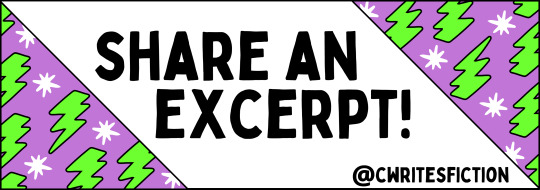
Share an excerpt that includes the words “big” or “small.”
Check the reblogs to read others’ responses!
If you’d rather make your own post, no problem!
Click here for more “share an excerpt” tips.
#the outer series excerpt#character: ariel#character: neuron#the outer series#the fall of Shatterthought
133 notes
·
View notes
Note
Could I request one for Haokah? It is a rare demon of Native American mythology and it comes from smt 2, a game out of the Devil Summoner series where they took ahold of the narrative and made demons with their first appearances?
Haokah - Day 60 (Request)
Race: Yoma
Alignment: Neutral/Neutral
June 21st, 2024
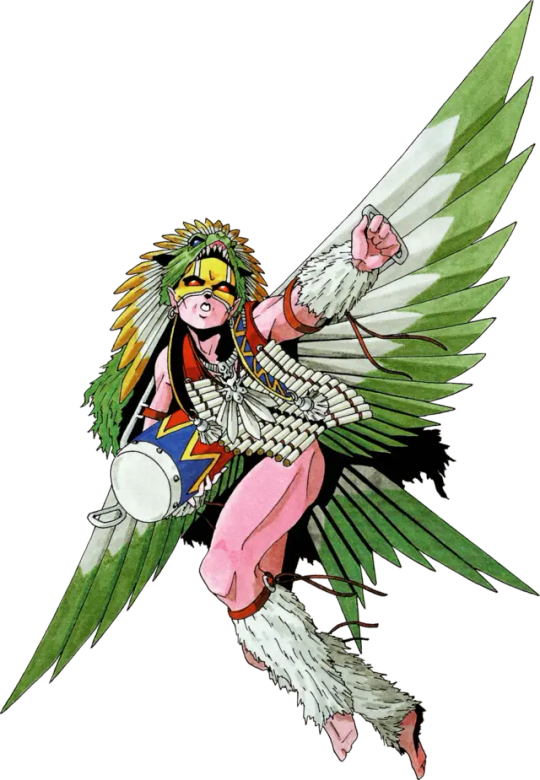
Wow, we've got a pretty obscure one today! As the series has continued, a lot of demons have unfortunately been left behind- whether it be due to changes of licensing, controversy, or simple forgetfulness, a lot of demons earlier in the series failed to recur later on, a rather unfortunate symptom of how many ideas they had that struggled to translate to the metaphorical big screen. Today's Demon of the Day is one of those, and one I'd love to see make a return- the tricky Jester at the top of the Lakota food chain, the Haokah.
Also called the Heyoka, this role is that of an incredibly important figure in Sioux folklore, someone blessed by and able to see the all-important figure of the Thunder Being. Contrary to the explanation in SMT, the Haokah is not a deity in-and-of-itself, instead being the role of someone who effectively works to be the exact opposite of those around them, calling into view questions of and satire relating to life itself. The Haokah will typically work as what could be best seen as a funhouse mirror, twisting and calling into effect the flaws of the society they live within by exaggerating the opposites.
When one becomes the Haokah, they are given the role of doing various incredibly foolish things, acting afool, almost like a jester who manifests during a performance. For example, if food was to be scarce, a Haokah may end up complaining about how full he was, or during a horse-riding ceremony, he may ride it backwards. One such example of this was an infamous Haokah literally called the straighten-outer, who, to quote an excerpt from 'Lame Deer Seeker of Visions', "...was always running around with a hammer trying to flatten round and curvy things (soup bowls, eggs, wagon wheels, etc.), thus making them straight."
Honestly, I have no idea where the SMT idea of the Haokah as a hunting god came from- it sent me for a bit of a loop, as it's the only place online that lists the Haokah as a hunting god instead of as the ceremonial role it actually is. Also, funny enough, a lot of posts online related to the Haokah have to do with someone being an empath of it? I won't even begin to pretend I understand what that means, but okay. Honestly, I wish they also did a bit more with the design- most interpretations of the Haokah are weird, and this one feels just a bit too plain? It feels like they're trying to play into the hunting god idea, which is not what the Haokah even is. I wish they took a bit more inspiration from contemporary depictions of the Haokah, but... well, it was very early in the series, so I can't fault them much.
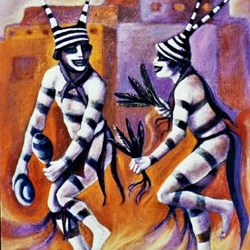

Still, flaws aside, I quite enjoy the fact that the series introduced me to such a unique concept! I guess I can see why they abandoned this demon down the road, though.
#shin megami tensei#smt#megaten#persona#daily#heyoka#the heyoka#the instant i read about how the heyoka works i thought of seika kijin from touhou lmao
13 notes
·
View notes
Text
My childhood (and first-ever toku) crush, Hiroshi Tsuburaya, in Uchuu Keiji Shaider (or just Shaider, which has been re-aired here in the Philippines several times). 😍 When he's not Shaider, he's Dai Sawamura, but to us he'll always be Alexis 😘
And he was one of the reasons why I got into Ultraman in the first place, not knowing then that he belonged to the clan that started and popularized the franchise. He was the grandson of Ultraman creator Eiji Tsuburaya and son of director/producer Hajime Tsuburaya, whom Hiroshi portrayed in Ultraman Tiga's 49th episode. He appeared in other Ultra series (Dyna, Gaia, Heisei Ultraseven) and a handful of Ultra movies.
I'm glad to have seen Shaider again. Nostalgic!!! ☺️
Excerpt of one of my favorite Shaider episodes (46th), where Priestess Poe (Ida in the Filipino-dubbed version) goes all out in killing Shaider through her "Phantom Showtime" torture with the aid of the remaining Hessler Girls (I referred to them as "mga babae ni Fuma Lay-ar" haha) and Beasts (Here she is changing attire while exhausting Shaider).
Until very recently, I really thought that Ida was portrayed by an actress. But he was played by Jun Yoshida, who's actually a guy, and so I've been lied to for a long, long time. 😅
Yoshida also auditioned for Dai/Shaider but Hiroshi ultimately got the role. But what if Yoshida portrayed Shaider... (in Ida's voice) "Code Name Shaider... ngayon din!" 😂
Hiroshi is sorely missed... now Shaider is patrolling somewhere in the vast, endless outer space... 🥺
#Uchuu Keiji Shaider#Space Sheriff Shaider#Shaider#Dai Sawamura#Alexis del Mundo#Hiroshi Tsuburaya#Priestess Poe#Ida#Jun Yoshida#Metal Heroes#tokusatsu#childhood crush#Toei#ctto
2 notes
·
View notes
Note
Tell me about “Human” since I have a Halo fic by almost the same name 😂
Ours are very different, and yours is definitely the better of the two.
The idea is that after the battle of Fumirole - when Kat lost her arm and the original Noble Six died - Carter stumbles upon Kat trying to get used to her new prosthetic. She is furious at herself for not picking it up immediately, but she is more concerned with blaming herself for Thom's death. Carter is also busy blaming himself for Thom's death.
Writing it because gol dang do those two need a constant infusion of hurt/comfort or I will spontaneously combust. @whotookmytomato knows what I'm talking about.
Here's the opening excerpt!
---
0203 Hours, April 27, 2552 (Military Calendar)
Aboard UNSC Frigate Prairie Fire
Carter-A259 stalked carefully down the corridor toward the hangar. Even though he was still clad in the extremely high-tech and armored MJOLNIR undersuit, he felt naked. Vulnerable. He was used to seeing the world from behind the protective shield of his helmet, but his outer armor had been stripped for repairs. It was practically unrecognizable after the last battle they fought. The last battle they lost.
Fumirole.
Thom.
The Spartan ran a hand through his short-cropped hair. There would be time to mourn friends - time to figure out just how he had failed his teammate - later. At the moment, there were more pressing concerns; the remainder of his team were taking the loss hard, and they had preparations to make for whatever mission was coming next for them. He’d lost one of the people closest to him… he had to take care of who he had left.
Which was what brought him to the hangar.
A series of loud clangs echoed from the hangar, reverberating down the largely empty corridor he was currently traveling. Up ahead, he saw a pair of Ensigns and a Marine rush out into the hall like , throwing concerned glances over their shoulders before disappearing in the other direction.
Amidst the clanging and booming echoing through the doorway they had fled through, Carter caught the sound of a very angry-sounding woman.
Kat.
2 notes
·
View notes
Text
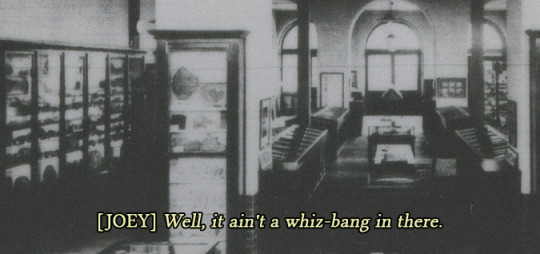
Excerpt St. Guess
↳ Joey peered hard through the doors, cupping his hands around his eyes to get a better look inside. "Huh," he muttered, his breath fogging the glass in front of his face. "Well, it ain't a whiz-bang in there. Guess it's not open after all. Let's come back tomorrow."
Mickey looked in over Joey's shoulder and his expression settled on a concentrated frown. Farther inside the museum, in front of what Mickey could vaguely make out to be the security office, a man in a tan single-breasted suit without a hat spoke to a much more refined, older gentleman. The younger man took a catalog envelope from the older man and smiled personably, patting him on the shoulder and engaging with him directly, holding grateful eye contact. The older man smiled as well, shaking his hand as his brows pitched in apology.
"Are there people inside?" Joey asked.
Mickey watched the younger man laugh at something and turn toward the front of the museum. "Security guard talking to the director. Likely picking up a series of misplaced paychecks."
Joey stepped away from the door and urged Mickey to do the same. "What?"
"During the renovations, the staff paychecks were either misplaced, improperly handled, or halted," Mickey explained as he moved to stand closer to Joey. "One of the security guards has just received his back pay."
"How do you do that?" Joey shrugged, mystified. "One of these days, you gotta tell me how you do that."
"And give away my secrets? Joey." Mickey tutted with a grin. "It's fairly obvious."
"If it was obvious, d'you think I'd be standin' here makin' myself look stupid?"
"Hmm," Mickey intoned, choosing at the benefit of everyone not to respond to that otherwise.
The security guard opened the door, brushing past the pair as he exited. "'Scuse me, fellas," he said, gracing them both with the same warm smile Mickey had seen inside the museum.
Mickey locked eyes with him for one moment that dragged on like several. Neatly combed, blue-black hair—dyed. Shiny. Slicked down with pomade. His eyes were green, full of life, youthful in contradiction to the shallow crow's feet at the outer corners. His smile could have illuminated an entire room.
He shifted the envelope to his other hand and bounded down the steps.
Mickey watched him, his gaze tight. Willing the man to glance back at him.
Some physical distance grew between them before he did just that. He threw one last look behind him, halfway across the street, and the friendly smile developed into one of deep understanding…an acknowledgement of words unspoken, or perhaps a pass of pleased appraisal.
Joey's stare bounced from the man to Mickey. "You know him?"
"No," Mickey said.
But he was sure he would.
#excerpt#St. Guess#St. Guess trilogy#ahahaaa that's Tod#incredibly gay crime syndicate book set in the 30s 40s and 50s that crosses over and through the first Partners installment when?
4 notes
·
View notes
Text
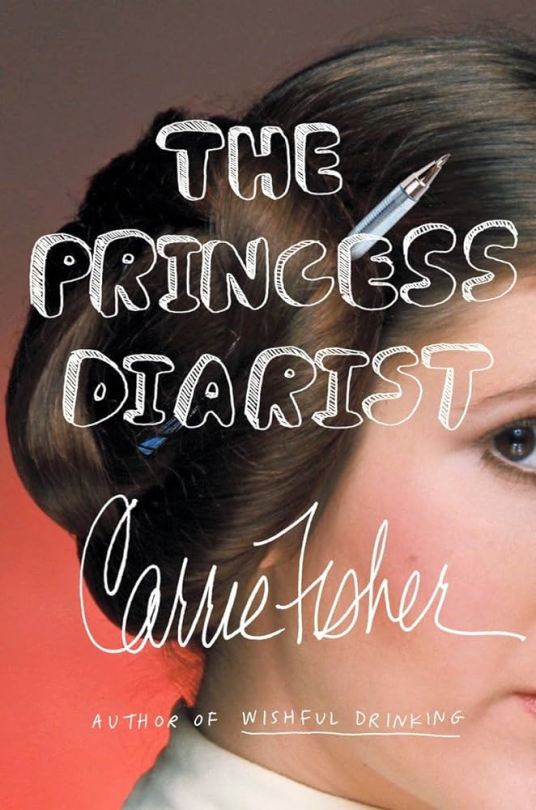
The Princess Diarist. By Carrie Fisher. Blue Rider Press, 2016.
Rating: 3.5/5 stars
Genre: memoir
Series: N/A
Summary: When Carrie Fisher discovered the journals she kept during the filming of the first Star Wars movie, she was astonished to see what they had preserved--plaintive love poems, unbridled musings with youthful naiveté, and a vulnerability that she barely recognized. Before her passing, her fame as an author, actress, and pop-culture icon was indisputable, but in 1977, Carrie Fisher was just a teenager with an all-consuming crush on her costar, Harrison Ford.
With these excerpts from her handwritten notebooks, The Princess Diarist is Fisher's intimate and revealing recollection of what happened on one of the most famous film sets of all time--and what developed behind the scenes. Fisher also ponders the joys and insanity of celebrity, and the absurdity of a life spawned by Hollywood royalty, only to be surpassed by her own outer-space royalty. Laugh-out-loud hilarious and endlessly quotable, The Princess Diarist brims with the candor and introspection of a diary while offering shrewd insight into one of Hollywood's most beloved stars.
***Full review below.***
CONTENT WARNINGS: alcohol, adultery
The aspect of this book I liked best was Carrie's honesty. Carrie holds nothing back and is quite upfront about her insecurities, her naivite, and her desire to please. The effect is that this memoir reads like a snapshot of a teenage girl who is starstruck by a much older man, and it's both hilarious and a little sad (in that Harrison Ford comes across as... not great).
Let's just get this part out of the way: this is not an in-depth behind-the-scenes look at the filming of Star Wars. The book jacket and marketing might be a little misleading on that front. If you're here for more Star Wars trivia or juicy gossip from one of the franchise's buggesy stars, best go elsewhere.
What this is, more than anything else, is Carrie's reflection on a number of things: her relationship with Harrison Ford while she was was a teenager and he was married and in his mid-thirties, how so-called "washed up" actresses struggle to make a living, the complicated feelings Carrie has regarding conventions and fame. For what it is, this book is endlessly funny, raw, and heartbreaking, moving from Carrie's characteristic humor and self-deprication to a hard-hitting insight into the workings of Hollywood and celebrity fandom.
Still, I don't think I can give this book more than 3.5 stars because there were aspects of Carrie's writing that didn't click for me. Some of her phrasing was a little awkward, and sometimes she would veer off in different directions (which is fine - that's the way her mind works - but it is also hard to follow sometimes). I also would have liked Carrie to deliver some sort of takeaway for each chapter - not necessarily a "moral to the story," but a clear(er) verbalizarion of the insights she gained by reflecting on the stories she's told.
The excerpts from her diary were also nice little insights to Carrie's headspace at the time, and if you care about Carrie as a person (not just Carrie as Princess Leia), they're a lovely look into the way her mind works.
But perhaps the section I liked best was Carrie's chapter on conventions. I found her honesty and complexity to be incredibly insightful and it shines a light on what she had to deal with for 40 years after the first Star Wars film.
Still, I'm glad I read this book. It's quick, it's amusing, and the photos are charming and nostalgic. The book perhaps hits a little different because both Carrie and her mother are gone, so some of my good feeling might be influenced by me being a fan who misses these icons. But if you love Carrie, you'll cherish this chance to "hear" her voice again.
2 notes
·
View notes